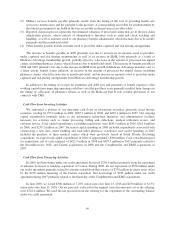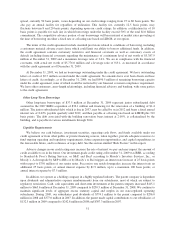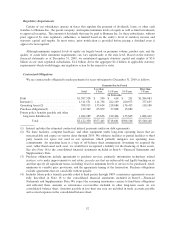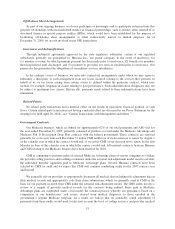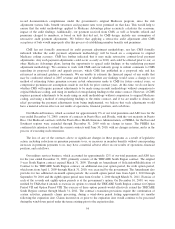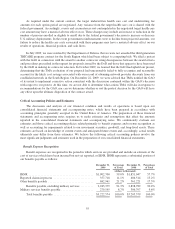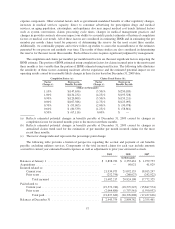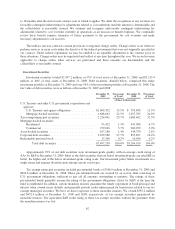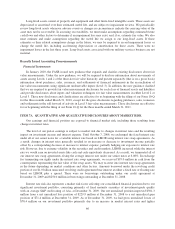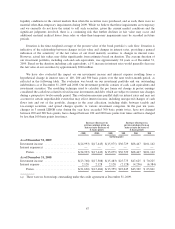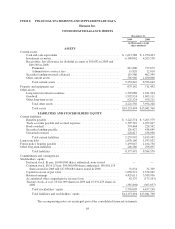Humana 2009 Annual Report Download - page 69
Download and view the complete annual report
Please find page 69 of the 2009 Humana annual report below. You can navigate through the pages in the report by either clicking on the pages listed below, or by using the keyword search tool below to find specific information within the annual report.Our TRICARE contract contains provisions whereby the federal government bears a substantial portion of
the risk of financing health benefits. The federal government both reimburses us for our cost of providing health
benefits and bears responsibility for 80% of any variance from the annual target health care cost and actual health
care cost as more fully described beginning on page 61. Therefore, the impact on our income from operations
from changes in estimate for TRICARE benefits payable is reduced substantially by corresponding adjustments
to revenues. The net decrease to income from operations as determined retrospectively, after giving consideration
to claim development occurring in the current period, was approximately $7.8 million for 2008 and $13.7 million
for 2007. The impact from changes in estimates for 2009 is not yet determinable as the amount of prior period
development recorded in 2010 will change as our December 31, 2009 benefits payable estimate develops
throughout 2010.
Future policy benefits payable of $1,193.0 million and $1,164.8 million at December 31, 2009 and 2008,
respectively, represent liabilities for long-duration insurance policies including long-term care, health, and life
insurance policies and annuities sold to individuals for which some of the premium received in the earlier years is
intended to pay anticipated benefits to be incurred in future years. These reserves are recognized on a net level
premium method based on interest rates, mortality, morbidity, withdrawal and maintenance expense assumptions
from published actuarial tables, modified based upon actual experience. The basis for the liability for future
policy benefits is established at the time each contract is acquired and would only change if our experience
deteriorates to the point the level of the liability is not adequate to provide for future policy benefits. Future
policy benefits payable include $571.9 million at December 31, 2009 and $503.2 million at December 31, 2008
associated with a closed block of long-term care policies acquired in connection with the November 30, 2007
KMG acquisition. Long-term care policies provide for long-duration coverage and, therefore, our actual claims
experience will emerge many years after assumptions have been established. The risk of a deviation of the actual
morbidity and mortality rates from those assumed in our reserves are particularly significant to our closed block
of long-term care policies. We monitor the loss experience of these long-term care policies and, when necessary,
apply for premium rate increases through a regulatory filing and approval process in the jurisdictions in which
such products were sold. We filed and received approval for certain state premium rate increases in 2009 and
continue to expect to file for premium rate increases for additional states in 2010. To the extent premium rate
increases and/or loss experience vary from our acquisition date assumptions, future adjustments to reserves could
be required. In addition, future policy benefits payable include amounts of $225.0 million at December 31, 2009
and $232.0 million at December 31, 2008 which are subject to 100% coinsurance agreements as more fully
described in Note 18 to the consolidated financial statements included in Item 8.—Financial Statements and
Supplementary Data, and as such are offset by a related reinsurance recoverable included in other long-term
assets.
As previously discussed, our reserving practice is to consistently recognize the actuarial best estimate of our
ultimate liability for claims. Actuarial standards require the use of assumptions based on moderately adverse
experience, which generally results in favorable reserve development, or reserves that are considered redundant.
The amount of redundancy over the last three years primarily has been impacted by the growth in our Medicare
business, coupled with the application of consistent reserving practices. When we recognize a release of the
redundancy, we disclose the amount that is not in the ordinary course of business, if material. We believe we
have consistently applied our methodology in determining our best estimate for benefits payable.
Revenue Recognition
We generally establish one-year commercial membership contracts with employer groups, subject to
cancellation by the employer group on 30-day written notice. Our Medicare contracts with CMS renew annually.
Our military services contracts with the federal government and our contracts with various state Medicaid
programs generally are multi-year contracts subject to annual renewal provisions.
Our commercial contracts establish rates on a per member basis for each month of coverage. Our Medicare
and Medicaid contracts also establish monthly rates per member. However, our Medicare contracts also have
additional provisions as outlined in the following separate section.
59


